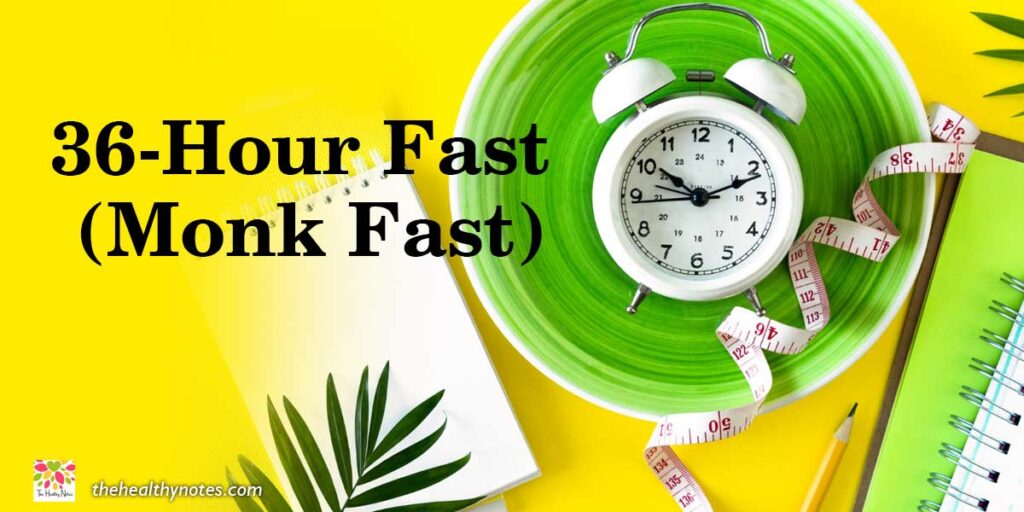
A 36-hour fast(Monk-Fast) is a type of intermittent fasting in which an individual refrains from consuming any caloric food or beverages for a continuous period of 36 hours.
During this fasting window, only non-caloric beverages such as water, herbal tea, black coffee (without added sugars or creamers), and plain electrolyte solutions are typically allowed to stay hydrated.
How 36-Hour Fast is Different From Intermittent Fasting?
A Monk Fast and intermittent fasting are both approaches within the realm of fasting, but they differ in terms of duration and fasting patterns.
Here are some key differences:
Duration: The primary difference is the duration of the fasting period. A 36-hour fast is a continuous fasting period lasting 36 hours, while intermittent fasting involves shorter fasting periods that can range from several hours to a day.
Frequency: Intermittent fasting is often practiced regularly, with specific patterns of fasting and eating days. In contrast, a 36-hour fast might be practiced less frequently due to its longer duration.
Fasting Patterns: Intermittent fasting methods involve various patterns, such as daily fasting windows or alternate-day fasting. A 36-hour fast is a specific extended fasting approach.
Ease of Adoption: Some people might find intermittent fasting methods more sustainable for incorporating into their routine, as they often involve shorter fasting periods. The 36-hour fast can be more challenging due to its longer duration.
Goals and Benefits: Both approaches share potential benefits like improved metabolism, weight management, and cellular health. However, the 36-hour fast’s extended duration may trigger deeper physiological effects, such as more pronounced autophagy.
Suitability: Intermittent fasting methods can be tailored to individual preferences and schedules. The 36-hour fast might require more planning and consideration, and it might not be suitable for everyone, especially those with specific health conditions.

Purpose of a 36-Hour Fast (Monk Fast)
Doing a 36-hour fast involves not eating for a day and a half, and it can have some amazing effects on our bodies. When we don’t eat during this time, it starts a bunch of good things happening inside us that make us healthier and stronger.
This includes making our cells fresh and strong, helping us burn fat better, and even making our brain work sharper.
This fasting helps our body become more adaptable and better at managing things. This can also help us control our blood sugar levels and improve how we use energy.
11 Health Benefits of 36-Hour Fast (Monk Fast)
A 36-hour fast, an extended form of intermittent fasting, can offer a range of potential benefits for your body and overall well-being. While individual responses can vary, here are some potential advantages of engaging in a 36-hour fast:
- Enhanced Fat Burning: During a 36-hour fast, your body taps into its fat stores for energy as glycogen reserves are depleted. This can promote effective fat burning and contribute to weight loss efforts.
- Cellular Autophagy: Fasting triggers a process called autophagy, where your body eliminates damaged cells and replaces them with new, healthy ones. This can help improve overall cellular health and may have implications for longevity.
- Improved Insulin Sensitivity: Fasting periods, including a 36-hour fast, can enhance your body’s response to insulin. This means your cells become more efficient at using glucose, potentially reducing the risk of insulin resistance and type 2 diabetes.
- Mental Clarity and Focus: Some people experience heightened mental clarity and focus during fasting periods. This could be attributed to the production of ketones, which are an alternative energy source for your brain.
- Resetting Eating Patterns: Engaging in a 36-hour fast can help you develop a healthier relationship with food and eating. It reinforces the idea that your body can function well without constant food intake.
- Discipline and Mindfulness: Fasting requires self-discipline and mindful eating practices. It encourages you to be more conscious of your eating patterns and make deliberate choices about when and what you consume.
- Weight Management: By encouraging fat burning and regulating insulin levels, a 36-hour fast may contribute to weight management and improved body composition.
- Cardiovascular Health: Some research suggests that intermittent fasting could have positive effects on cardiovascular health, including reducing risk factors like blood pressure, cholesterol levels, and inflammation.
- Longevity Potential: Fasting’s impact on cellular health, autophagy, and metabolism could potentially contribute to overall longevity and age-related disease prevention.
- Immune System Benefits: Fasting triggers a process that can help optimize your immune system, making it more efficient at protecting your body from infections and illnesses.
- Gut Health: Fasting can give your digestive system a break, potentially allowing it to reset and promoting better gut health.

How to Do a 36-Hour Fast?
Doing a 36-hour fast requires careful planning and consideration. Here are some points to be considerd:
1. Consult with a Healthcare Professional: Before starting a 36-hour fast or any form of fasting, it’s essential to consult with a healthcare professional, especially if you have underlying health conditions, are pregnant, breastfeeding, or taking medications.
2. Choose Your Fasting Window: Decide when you’ll begin and end your 36-hour fast. For example, if you finish dinner at 7:00 PM on Day 1, your fasting period will continue until 7:00 AM on Day 3.
3. Stay Hydrated: During your 36-hour fast, focus on staying hydrated. Drink water, herbal tea, plain black coffee (without added sugars or creamers), or electrolyte solutions. Hydration is important to help you feel better and support bodily functions.
4. Manage Hunger Pangs: It’s normal to experience hunger pangs during fasting. If you find hunger challenging, distract yourself with activities, go for a walk, or engage in light exercise. Keep in mind that hunger typically comes in waves and often subsides.
5. Listen to Your Body: Pay attention to how you feel during the fast. If you experience extreme weakness, dizziness, nausea, or any concerning symptoms, it’s important to break the fast and consume some nutritious food.

6. Break the Fast Gradually: When your fasting window ends, break your fast gradually with a small, balanced meal or snack. Opt for nutrient-dense foods like vegetables, lean proteins, and healthy fats. Avoid heavy food.
7. Choose Nutrient-Rich Foods: After the fast, focus on consuming whole, nutrient-rich foods to nourish your body. This will help replenish your energy and support recovery.
8. Monitor Your Body’s Response: Pay attention to how your body responds after the fast. Take note of any changes in energy levels, mood, digestion, and overall well-being. Everyone’s experience is different, so it’s important to gauge how your body reacts.
9. Be Consistent (Optional): If you’re considering incorporating 36-hour fasts regularly, be consistent in your approach. Some individuals choose to do these fasts once or twice a week, while others might prefer a less frequent schedule.
10. Adapt and Adjust: Remember that fasting isn’t one-size-fits-all. You might find that a 36-hour fast is too challenging initially. If that’s the case, consider starting with shorter fasting windows and gradually working your way up to longer durations.
11. Prioritize Safety: Your health and well-being should always come first. If at any point during your fasting journey you feel unwell, experience severe discomfort, or have concerns, it’s important to consult with a healthcare professional.

How to Break a 36-Hour Fast (Monk Fast) ? Or What to eat after a 36-Hour Fast?
Breaking a 36-hour fast requires some care.
Start with a small and balanced meal that includes healthy foods like vegetables, lean proteins, and good fats. Gradually introducing food helps your body adjust after fasting and prevents discomfort.
Drink water and stay hydrated. Pay attention to how your body reacts as you start eating again, and if you feel any discomfort, take it slow.
Listen to your body and give it the nourishment it needs to transition smoothly from fasting to eating.
Can Anyone do a 36-Hour Fast (Monk Fast)?
Fasting isn’t one-size-fits-all, and individual reactions can vary. The decision to attempt it, should be made thoughtfully and with careful consideration for your own health and well-being.
While many individuals can successfully complete a 36-hour fast, it’s important to consider your personal health, medical history, and individual circumstances before attempting an extended fast of this nature. Fasting affects different people in various ways, and not everyone should engage in such fasting practices.
It’s crucial to prioritize safety and listen to your body’s signals during fasting. If you experience dizziness, extreme weakness, nausea, or other concerning symptoms, it’s recommended to break the fast and consume food.

36-Hour Fast Once a Week Benefits
Engaging in a Monk fast once a week can offer numerous benefits for your health and well-being. This practice involves refraining from eating for a day and a half each week, and its advantages are impressive. Not only does it aid in weight management by promoting effective fat burning, but it also triggers cellular renewal through autophagy, leading to improved cellular health.
This routine encourages your body to become more adaptable in using energy, enhances insulin sensitivity, and fosters mindful eating habits. Embracing a once-a-week 36-hour fast can be a simple yet impactful way to boost your overall wellness.
Remember, it’s advisable to consult with a healthcare professional before starting any fasting regimen to ensure it aligns with your individual health needs.
36-Hour Fast Weight loss Results
Trying a Monk Fast can help you lose weight. When you fast for this long, your body starts using stored fat for energy, which can lead to losing extra weight. This, along with your body becoming better at using energy and renewing cells, can help you shed pounds.
But remember, everyone’s body is different. Before you try a 36-hour fast or any fasting, talk to a doctor. They can help you do it safely and make it work for you. For Weight loss 36-Hour Fast and Power Walking can be a amazing combination.
Conclusion
The Monk fast is a fasting strategy that delves deep into the body’s processes, encouraging metabolic adaptations and rejuvenation. It’s a practice that requires mindfulness, discipline, and a keen awareness of your body’s responses.
While it may not be suitable for everyone, for those who approach it thoughtfully and with professional guidance, it could be a pathway to experiencing enhanced metabolic flexibility, improved well-being, and a fresh perspective on the relationship between eating and health.
As you embark on your own fasting journey, remember that the goal is to prioritize health and well-being above all else. With the right approach, the 36-hour fast could be an avenue to unlocking the potential of your body’s innate capacity for renewal and vitality.
Very nice information on 36 hour Monk fast
Great
Keep it up
Wonderful site